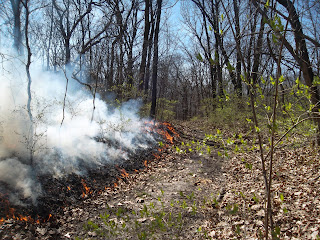Starting at the SE corner of the burn unit
Along the N border
Where the two fires met in the middle
of the N border
Critters
We saw a Barred Owl flush from the area, as well as a Red Bat. I found a Blackberry Seed Gall for the first time. From "Naturally Curious with Mary Holland" I learned, "Galls, abnormal plants growths caused by many agents including insects, are formed during the growing season on the buds, leaves, roots and branches of plants as a response to chemicals or physical irritation. These galls serve as shelters and a source of food for their inhabitants. Blackberry is host to numerous gall-making insects, including mites, midges and gall wasps, and their temporary homes (galls) are more obvious now that Blackberries have lost their leaves. The Blackberry Seed Gall is caused by a cynipid gall wasp, Diastrophus cuscutaeformis. This wasp gets its species name from the resemblance of the galls it forms to the fruit of Dodder or Cuscuta, a parasitic plant. A cluster of small, globular, seed-like galls within which the gall wasp larvae live are pressed together in a lump surrounding the cane. Each of these 1/10th-inch diameter chambers bears a spine, and together they create a reddish-brown hairy mass."
Blackberry Seed Gall (Above)
Warty Leaf Beetle (below) mimic caterpillar poop
One of the many kinds of True Bugs I saw that day.
I saw this plant frequently and while it looked familiar I couldn't place it. Eventually I found the answer and the basal leaves (1st year of growth) are very different looking from the upper growth (year 2), which maybe threw me off. This is a common native species, Stickseed, Hackelia virginiana.
Done with Fire Season for Spring 2017
Wish I could have burned my prairie, but
the weather wasn't in favor. The plants greened up
early with the warmer than average (record warmth) January/February.













No comments:
Post a Comment